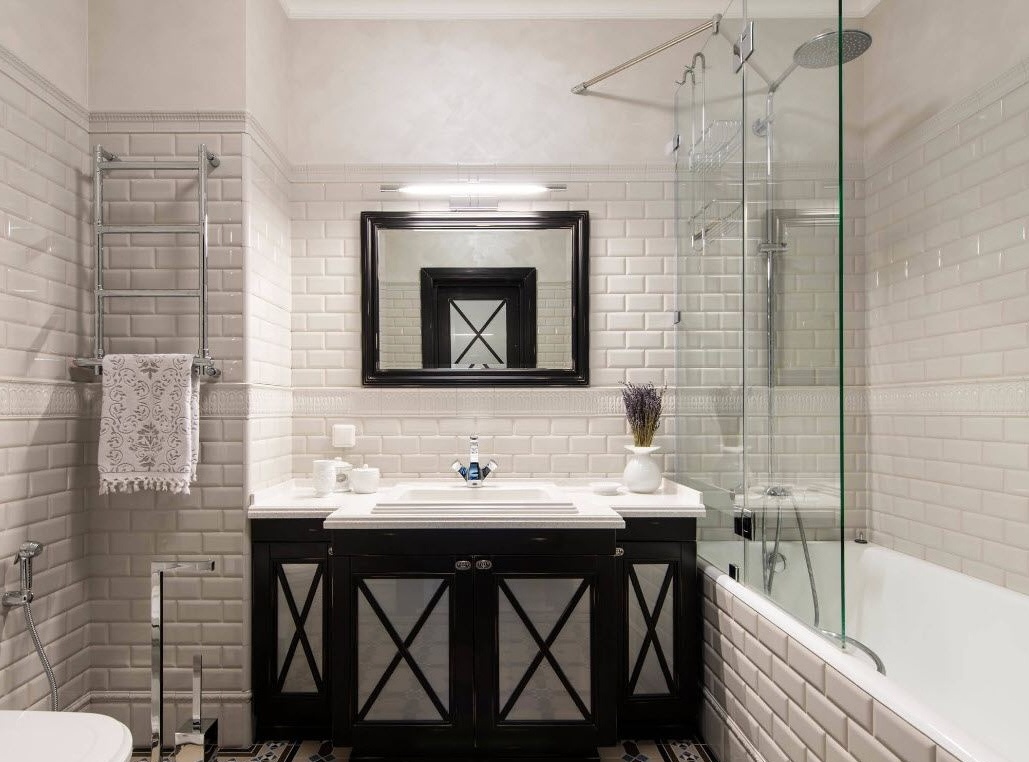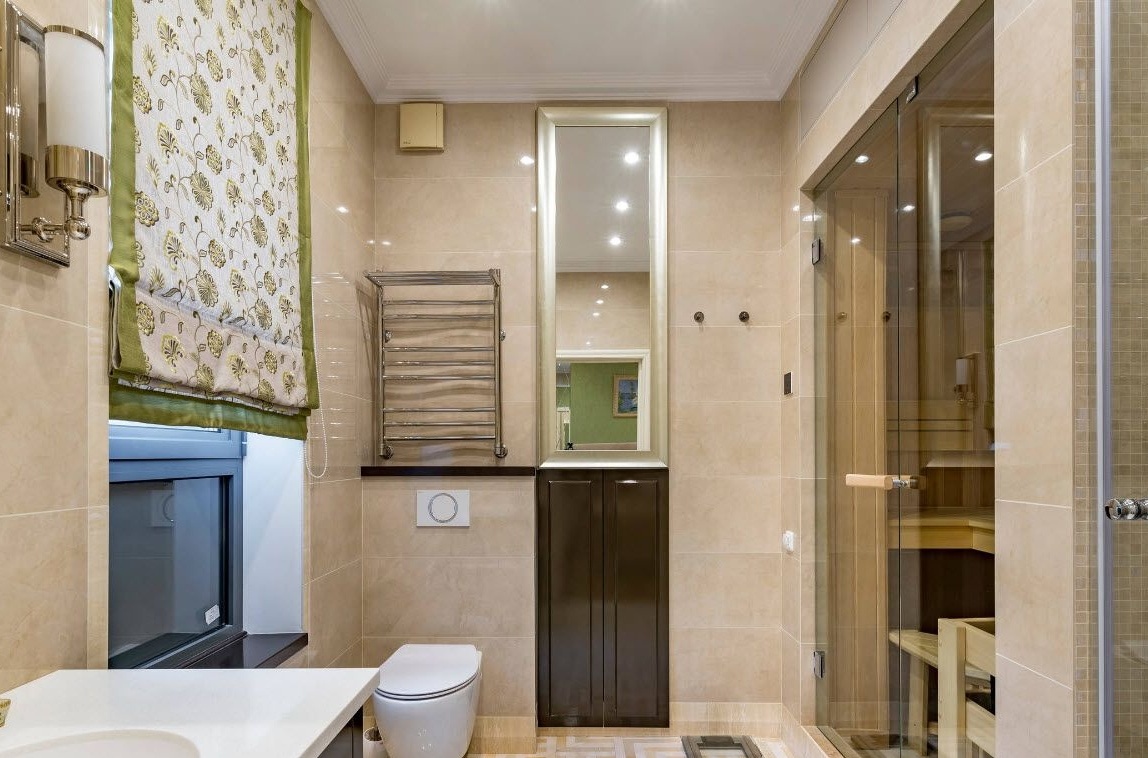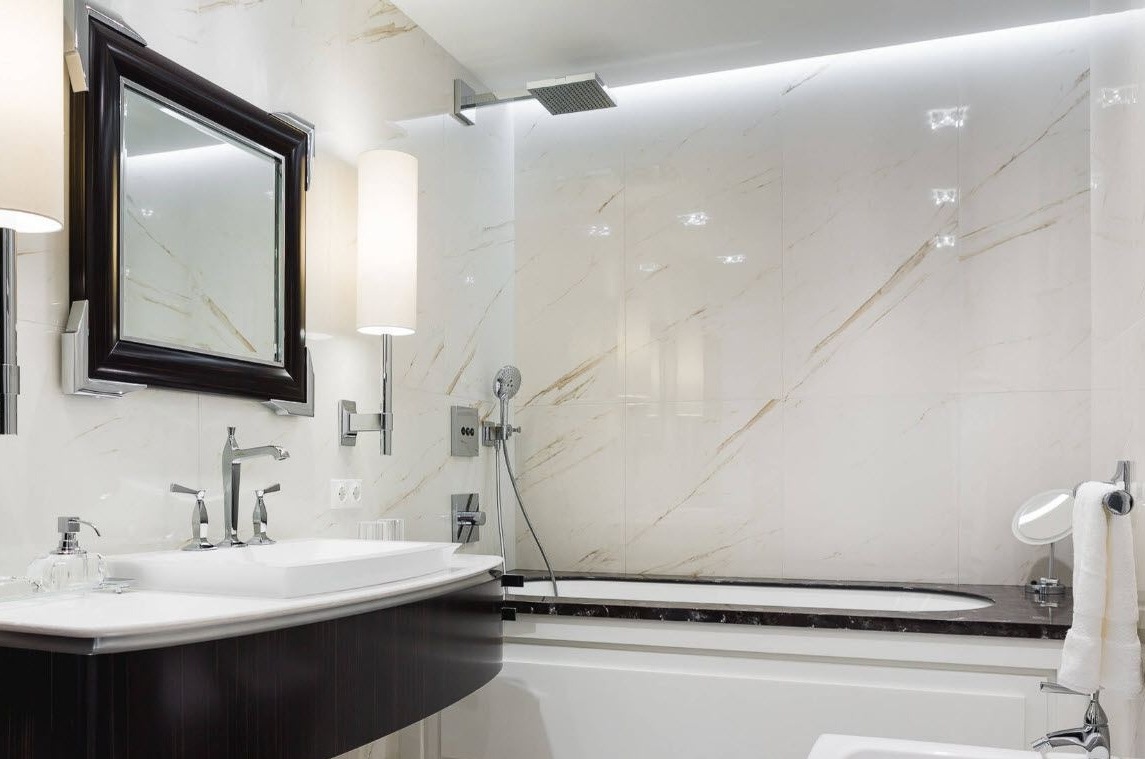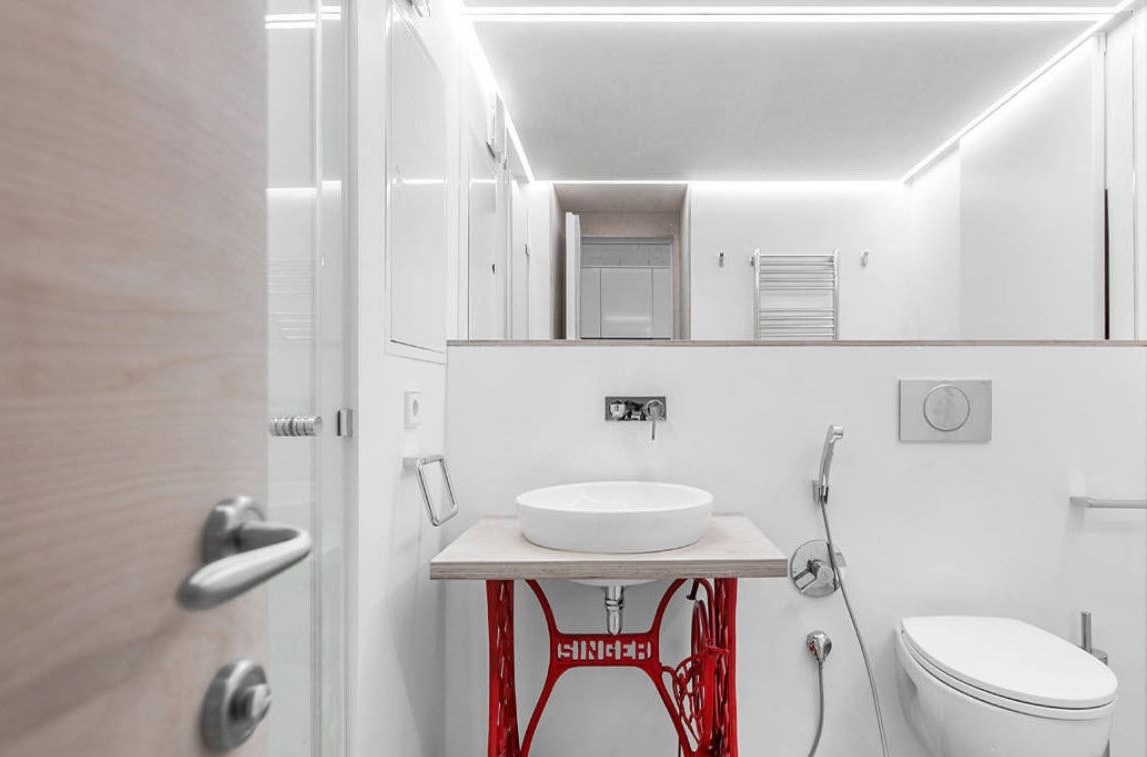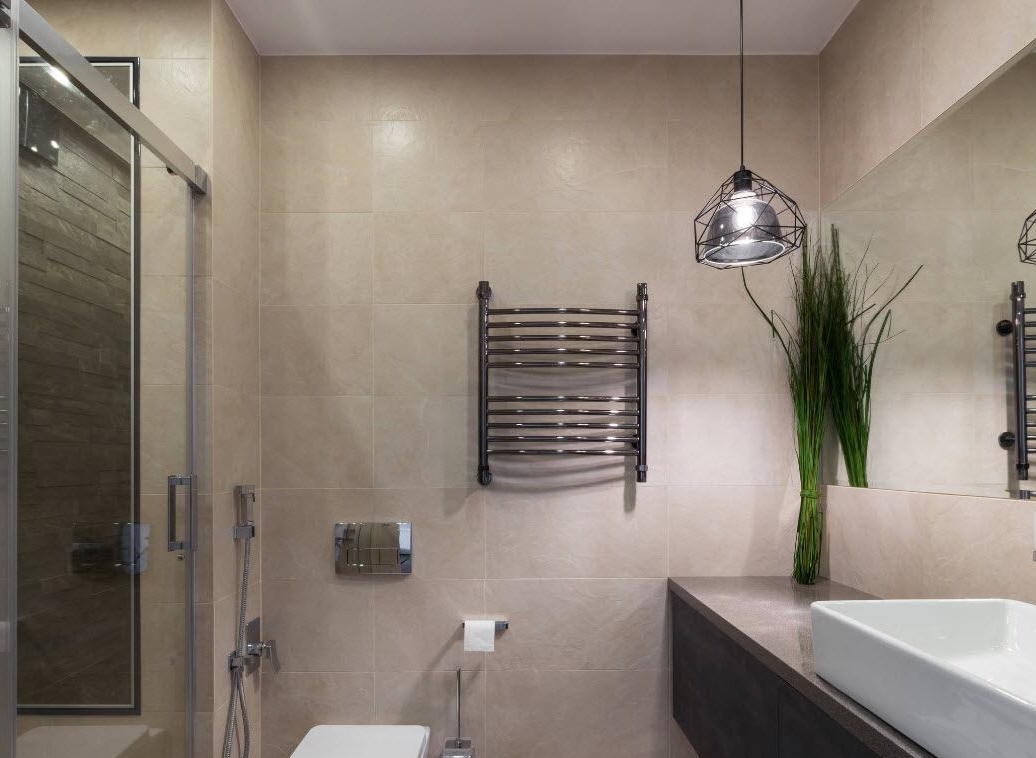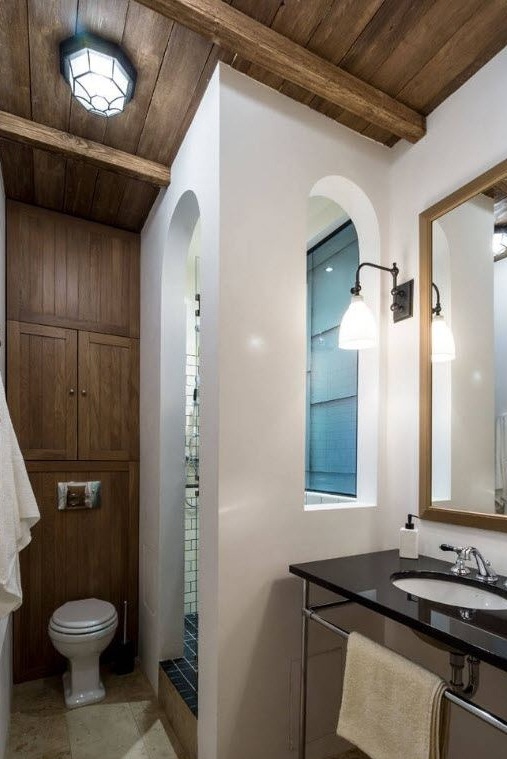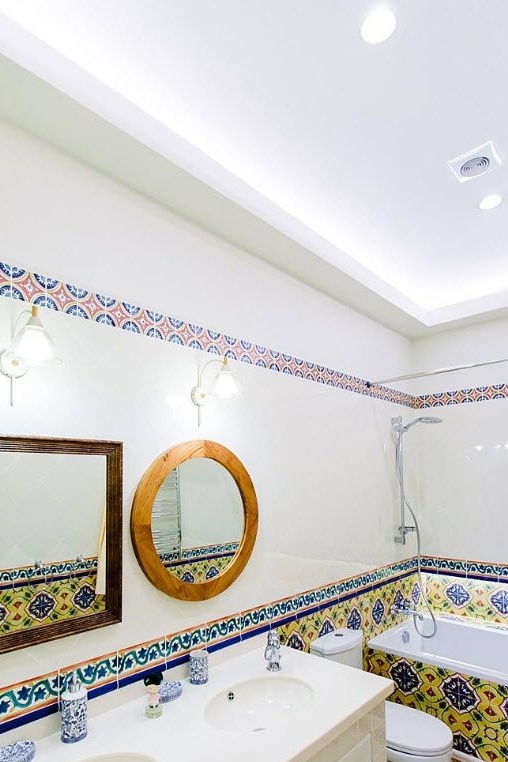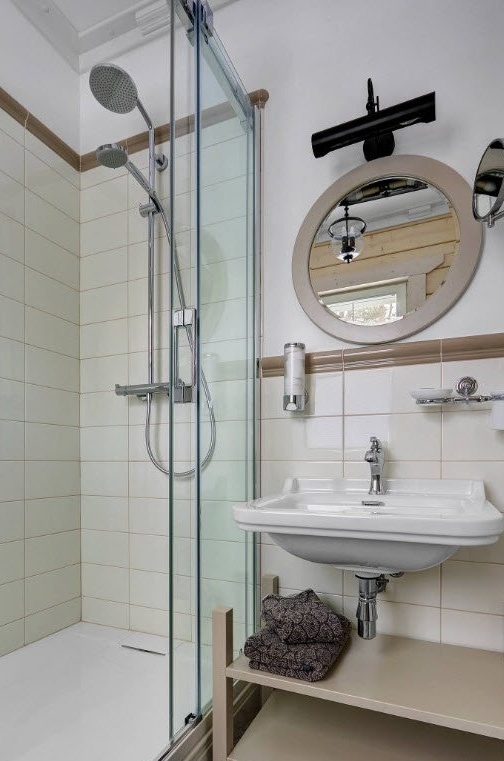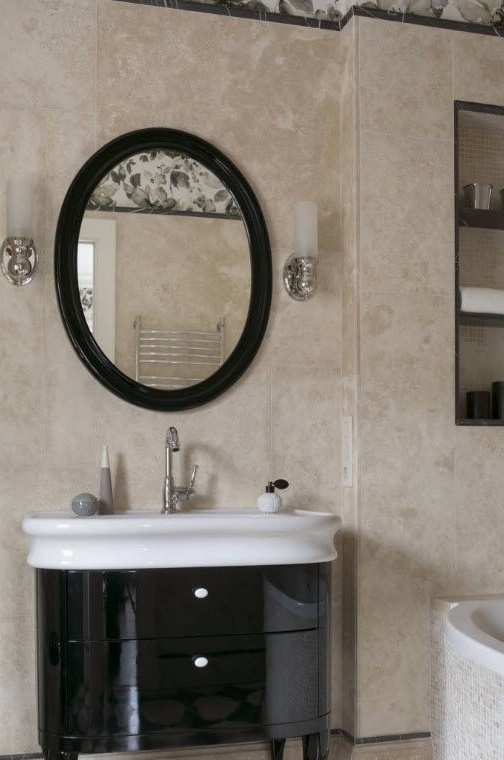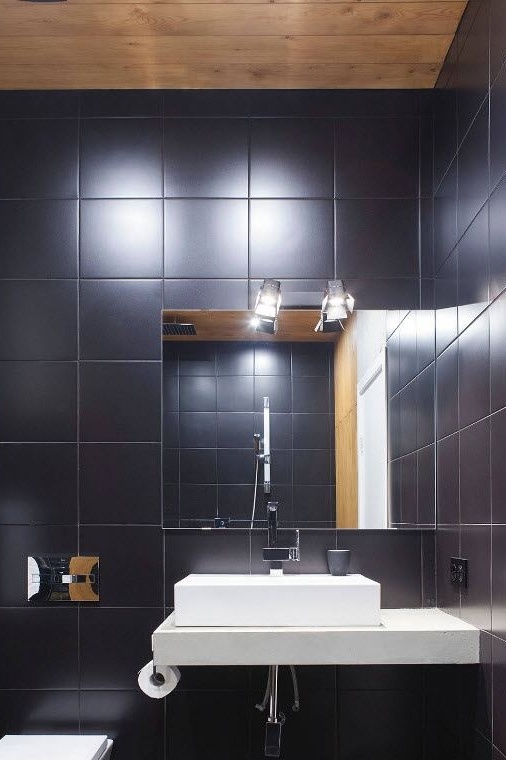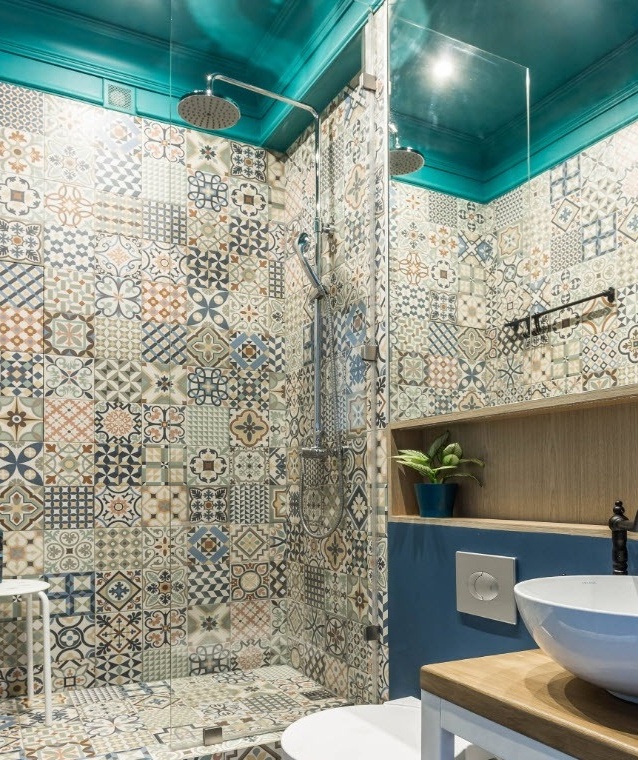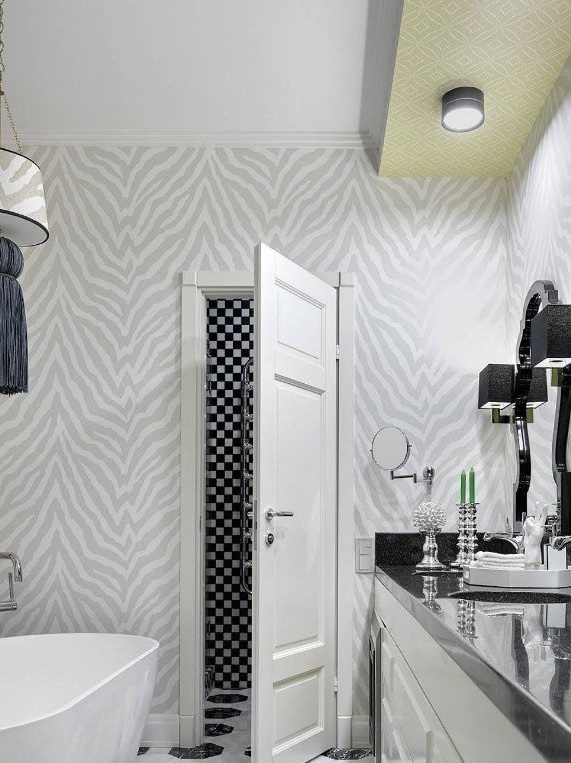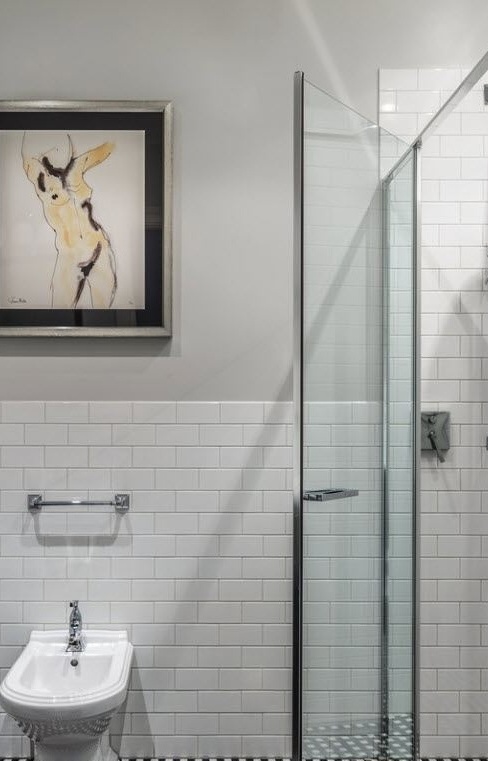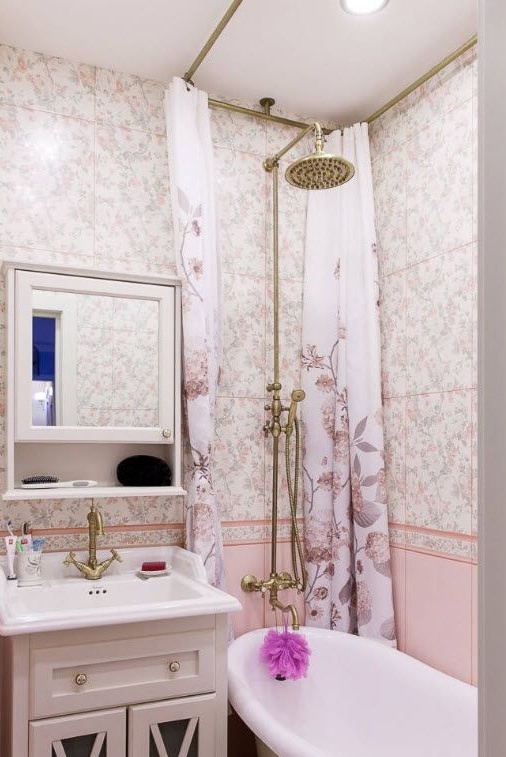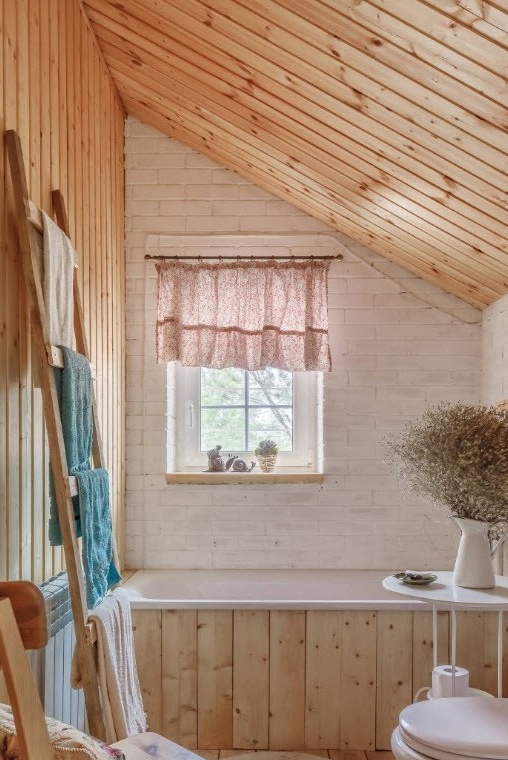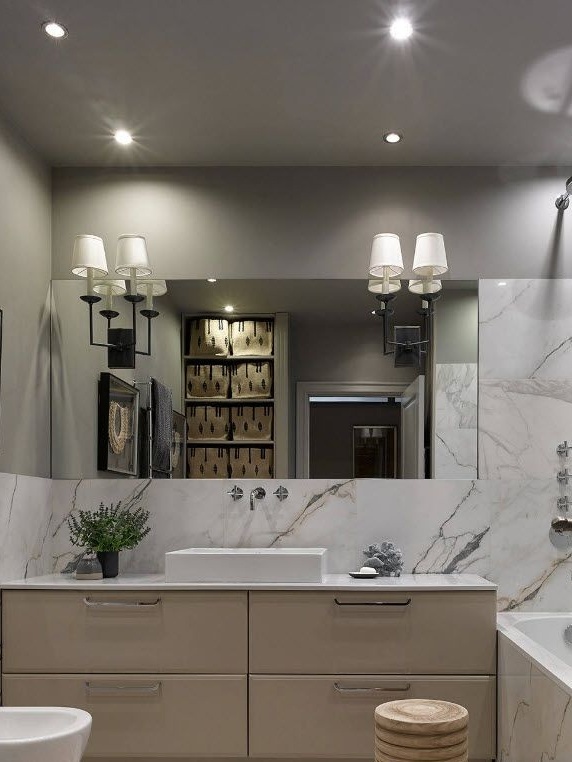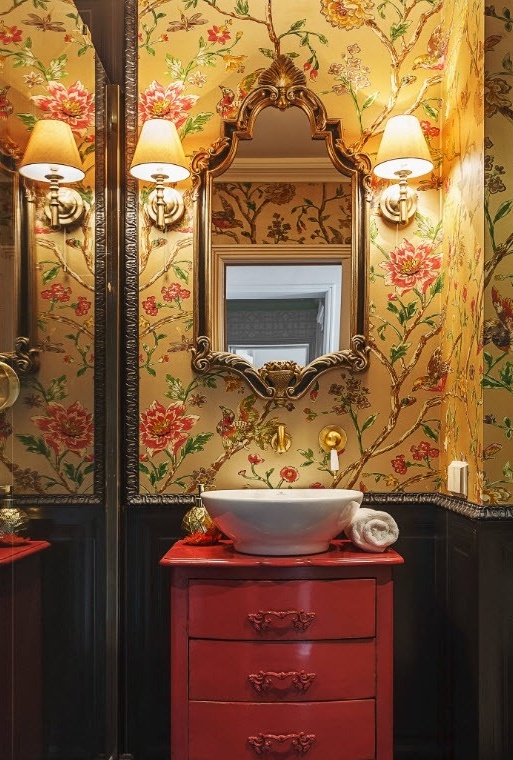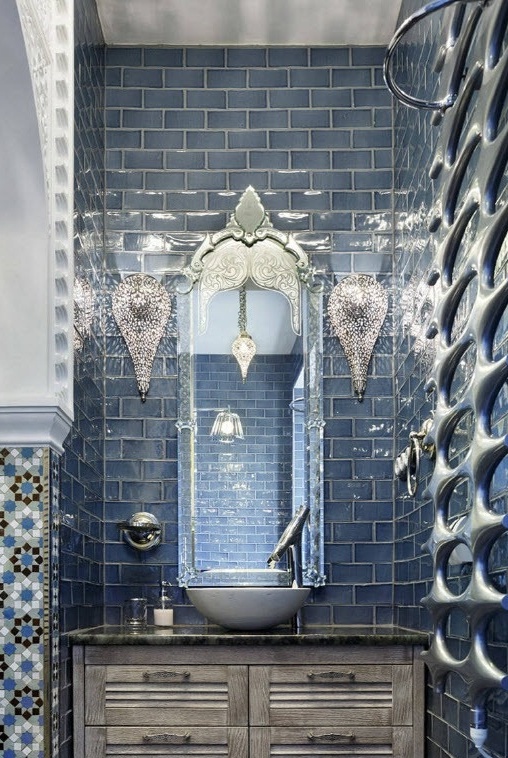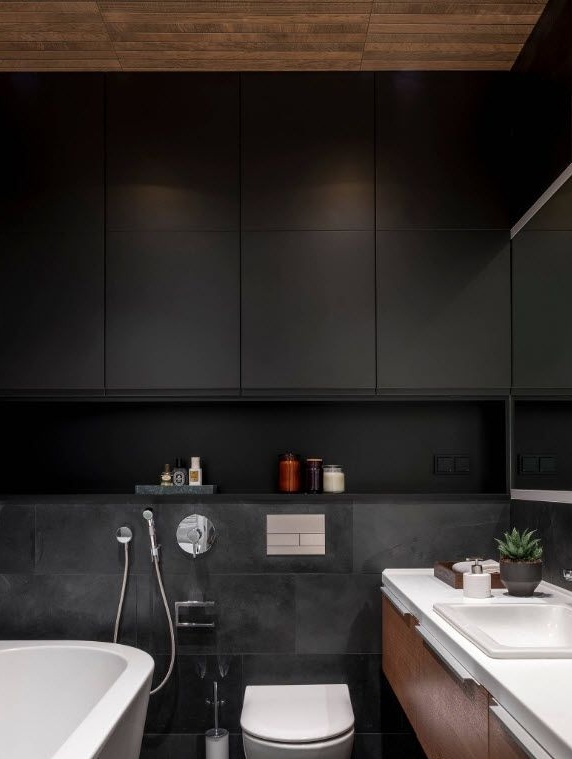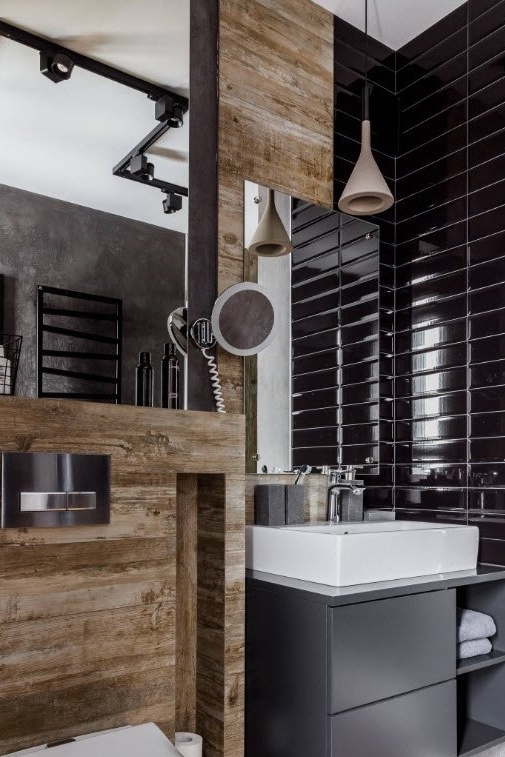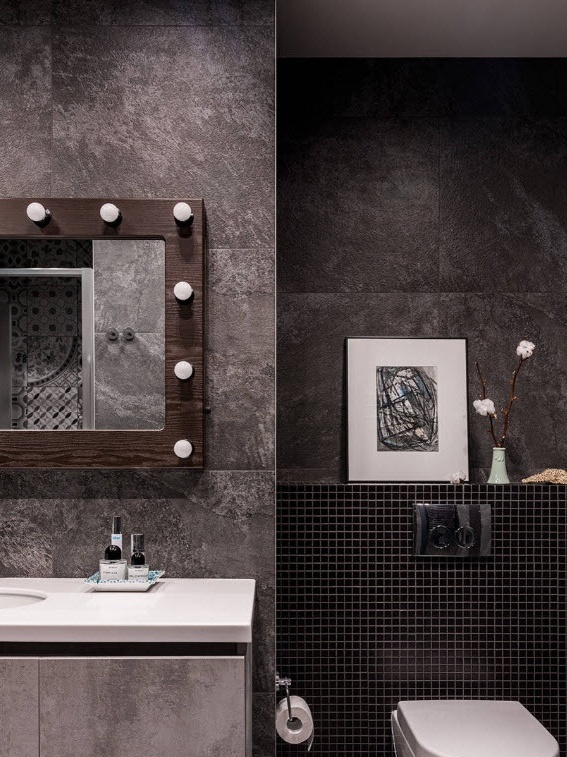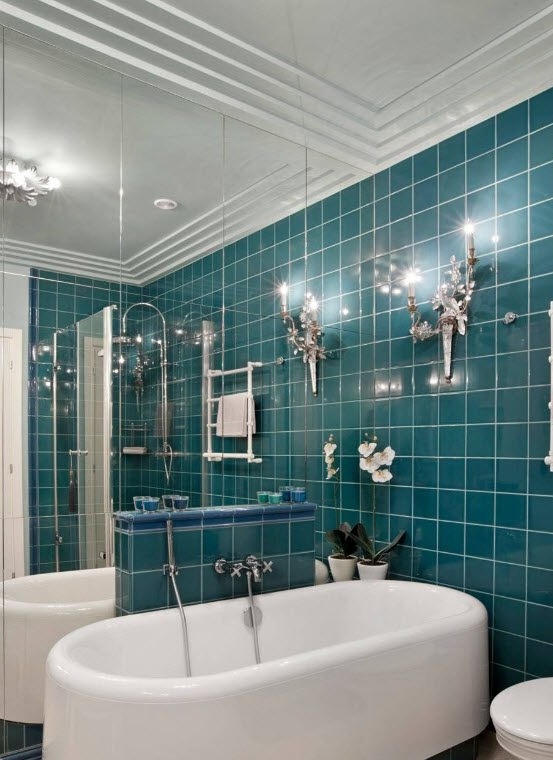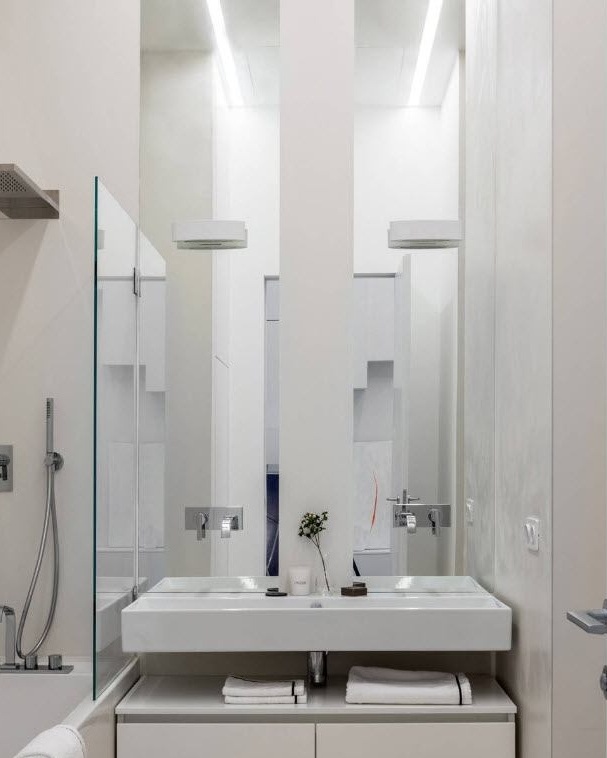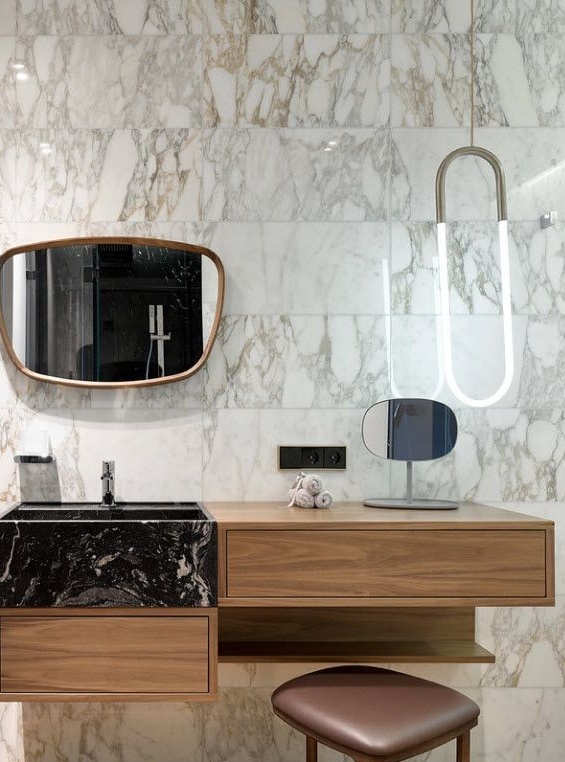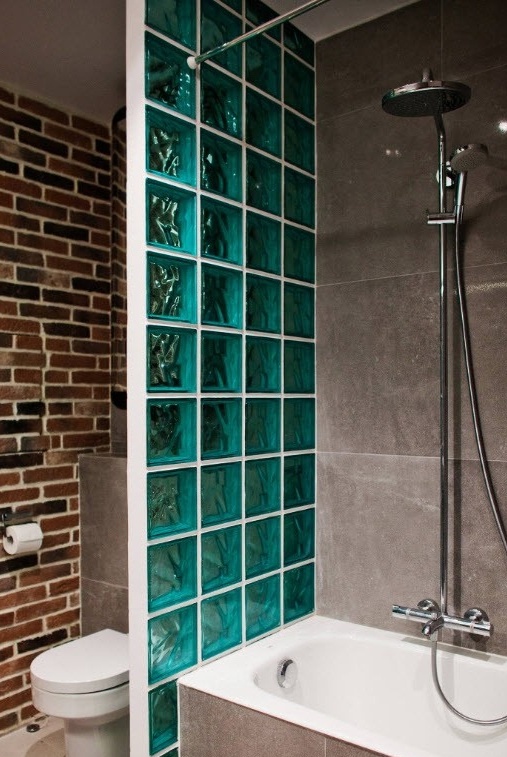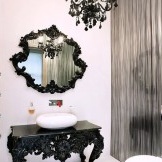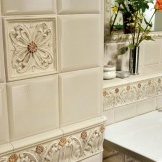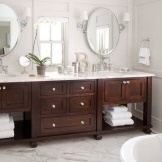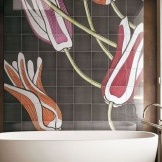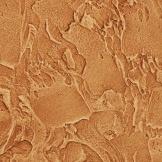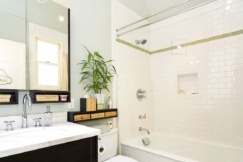Walls in the bathroom: a variety of finishing materials in a trendy design
Content:
- Features of the choice of material
- Different types of wood
- Wallpaper
- Paint
- Stone finish
- Decorative concrete
- Ceramic tile
- Panels on the wall
- Glass
- Ideas for a fashionable interior
- DIY tile laying
- How to paint the walls in the bathroom?
- Fashionable colors in the interior of 2019
Porcelain, concrete, paint, wallpaper, and maybe steel and wood! Immortal ceramic tiles have many competitors for wall decoration in the bathroom. The choice of materials for repair today is huge. It all depends on personal preferences in design, the style of the room and the size of your personal budget. Read the information in this article, which will allow you to learn about the types of wall decoration in the bathroom, taking into account all the nuances.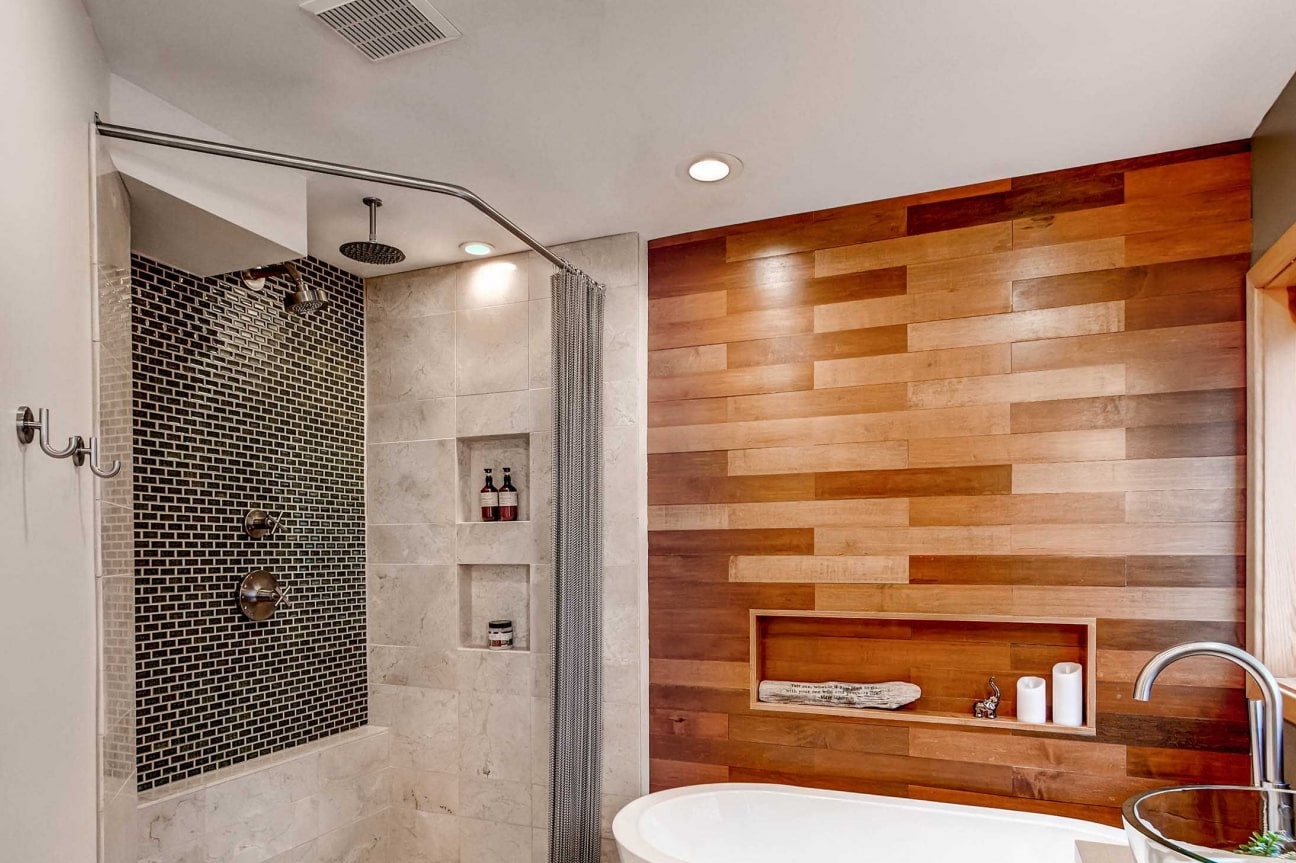
Walls in the bathroom: features of the choice of material for decoration
The bathroom is a place that is used not only for hygiene procedures, but also to improve mood and well-being after an exhausting working day. Here people relax, refresh themselves and for a moment forget about problems. Pleasant and aesthetic decor is preferred. The appearance of the floors and walls determines the overall design of the bathroom. Today there is a wide selection of finishing materials for premises of this type. The times when only ceramics were applied to the walls were in the past. Although tile is still popular and trendy, a different finish came into play:
The most important thing is that the material selected for the walls in the bathroom is practical and resistant to moisture, and you like the end result. For traditionalists who cannot part with tiles, good news. Modern ceramics is not similar to what existed several decades ago. The innovative tile imitates other materials such as lining or stone. She has new, bold patterns and shapes: from straight to heavily curved, with jagged edges, providing interesting compositions.
 Wall decoration bath: homely atmosphere or wood
Wall decoration bath: homely atmosphere or wood
Most often, exotic wood is used in bathrooms because of its durability, good moisture protection, and unusual color and structure. Highly moisture resistant wood is:
Exotic species that are more sensitive to moisture are:
As for domestic breeds, the most durable are:
Less resistant to moisture:
- Pine;
- spruce;
- cherry;
- pear.
The latter is best used in places not subject to direct contact with water. However, if you choose domestic wood, you must properly strengthen its resistance to external factors, using methods such as varnishing, lubrication, painting, waxing.
Wall-mounted bathtub
A good alternative to tiles is wallpaper. They perfectly mask uneven walls, are easy to apply and relatively inexpensive. For bathrooms, vinyl or fiberglass wallpaper is used, coated with acrylic varnish or epoxy. Since the bathroom has high humidity for gluing wallpapers, you should choose only waterproof glue. Wallpaper fits perfectly and blends with ceramic tiles. The vinyl version has a layered structure: paper inside and vinyl outside. This coating is resistant to light, so the wallpaper retains color and water resistance.
Fiberglass Wallpaper
Fiberglass wallpaper is very resistant to mechanical damage.On the walls can be successfully kept for several decades, they are difficult to remove from the wall. Fiberglass merges with the surface. This wallpaper is for painting.
What should be remembered when decorating a bathroom with wallpaper?
All wallpaper patterns can be varied using borders that have different widths of colored or patterned stripes. The border also serves as a trim. Although wallpapering is simple and does not require sophisticated tools, there are some important things to keep in mind to avoid peeling:
- If you decide to use wallpaper, you should not forget to choose the right glue and foundation primer. Today, a lot of quality glue is available on the market. Each wallpaper manufacturer can offer a specific product that is best suited for wallpapering. These materials must have vapor and waterproof properties.
- Remember the moisture resistance of the wallpaper and the dangers associated with it. It is advisable to apply wallpaper in a room that has effective rotational or mechanical ventilation so that the material is not exposed to prolonged contact with water. Experts do not recommend wallpaper for small bathrooms, because too much moisture can escape from the wall.
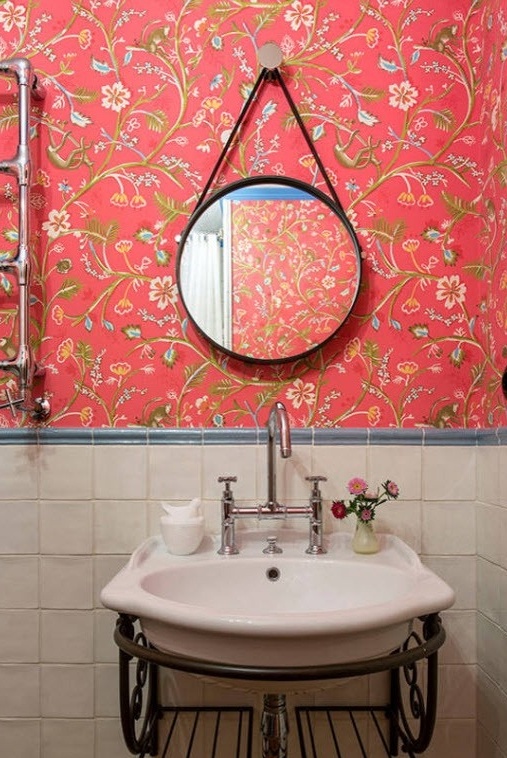
Paint for bath walls
Paints intended for wet rooms, in their composition, have special formulas that protect the painted surface from moisture and the development of various types of mold and fungi. Most often these are silver ions. They are available in a very wide range of colors, so you can perfectly match the color to the interior or furniture. Suitable properties, low price and ease of application on the wall make the paint a unique solution.
To paint a bathroom instead of tiles? A reasonable solution, since the paint for the bathroom protects the walls of the room from moisture and provides consistent colors. A bathroom without tiles is an increasingly popular solution. You can decorate surfaces with stickers, murals or even panels.
Tips & Tricks
Modern bathroom trends recommend minimal use of tiles, that is, only in a wet area. Is a bathroom without tiles practical? How to decorate the walls in the bathroom? You can paint the room, but do not forget to choose special substances that are resistant to moisture. It’s worth deciding on such a decision when we don’t have a shower, when you want to create a special room design, for example, a Provencal, romantic bathroom in a rustic style or just do not want to invest heavily in plumbing.
How to protect the walls of the bathroom from moisture when painting?
To paint the bathroom, use special paints that do not let moisture in and allow the wall to breathe. If the room is large, move the bathtub away from the wall, as this will protect the plaster from splashing. If the plumbing should be next to the wall, you can use a large format wall painting or attach a mirror surface to the tile. This bathroom wall decoration gives the interior a style and pleasant warmth that you always like. A bathroom without tiles will acquire an interesting and cozy character, and the color of the walls in the room will undoubtedly be easier to change next season than invest in a new tile.
Practical bathroom - flooring, stone walls
Stone is an extremely durable and waterproof material. Damage caused during use is very little visible, they can be easily fixed. It also adds elegance and class to even a small bathroom. In principle, any stone can be used in a hygiene room, provided that it is properly prepared, that is, polished and impregnated. When it comes to natural stone used at home in the bathroom, the most popular are:
- granite - almost the most durable, not requiring impregnation;
- travertine is very porous, which makes it quite susceptible to moisture; avoid its use in places with high humidity; It is suitable for the bathroom floor;
- marble - a wide selection of colors and structures, suitable for almost any interior, very effective on large surfaces, but loses its charm in a small bathroom;
- onyx - unusual, irregular in colors, fits perfectly into the mosaic on the wall of a small bathroom.

Wall decoration in the bathroom with decorative concrete
Concrete is increasingly used in the design of modern bathrooms. Due to its strength, it is used as a finishing material for floors. The material is perfectly smooth. It blends wonderfully with spaces designed both in minimalist aesthetics and in glamor-style interiors with rich, shiny accessories. In the bathroom, concrete can be used in places such as vanity tops, bathtubs or pallets.
The recommended solution is the use of architectural concrete slabs, which are characterized by high mechanical strength and water resistance. The arrangement of the bathroom, through the use of this material, will acquire a unique charm.
Wall tile in the bathroom is still fashionable
True, the choice of materials for the walls is very large, but customers do not forget about the tiles. It is fashionable, the structure resembles panels of metal, steel and precious stones. Manufacturers presented such design lines as wood, fiori, gold, silver, steel and green stone. Tiles can be of different sizes and shapes. In addition, decorative elements, inserts and inlays can be introduced. Tiles with jagged edges are still in fashion, matching the antique Mediterranean and rustic style.


Panels on the wall in the bath
Wall panels are a great way to create a spectacular finish in a hygiene room. A variety of panel designs, a wealth of textures and colors allows you to create any composition. Another advantage of bathroom panels is their easy assembly.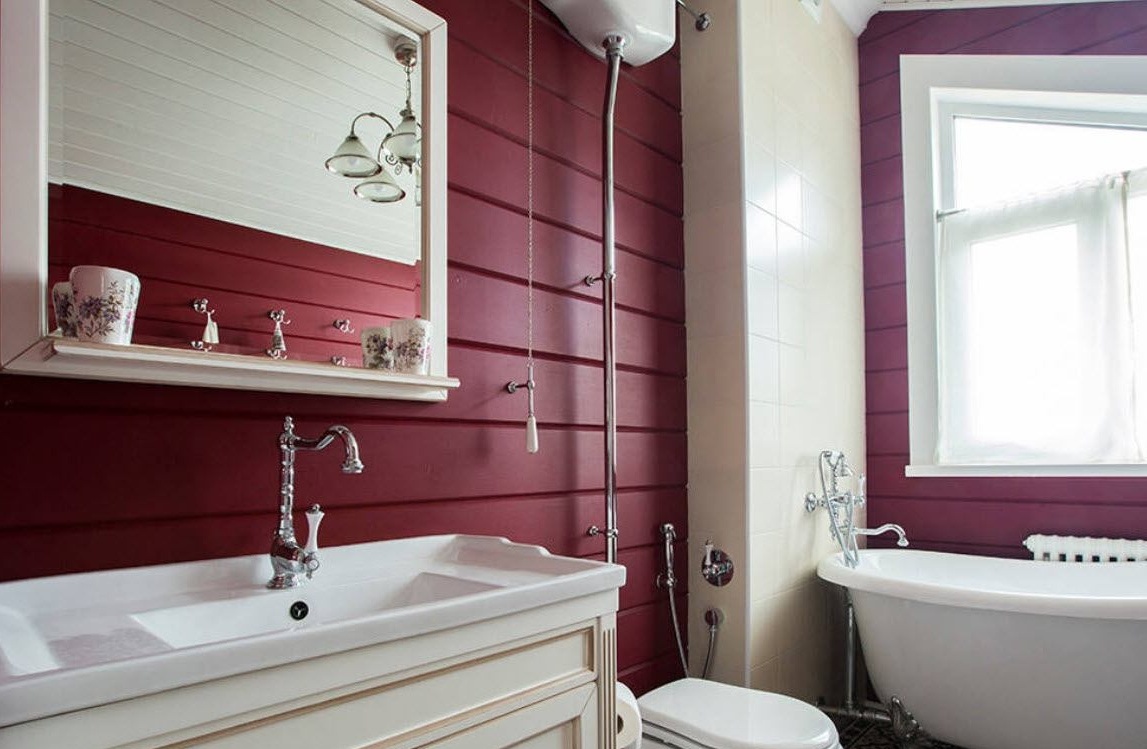
Bathtubs with a glass wall
Glass has a different thickness, transparency, patterns and colors. First of all, the bathroom uses safety tempered glass, glued or reinforced. A blow breaks such material into pieces with unfocused edges, splashes, or just a network of cracks on the sheet. Luxpheres and blocks are popular. They have various sizes and shapes: square, triangular, rounded. Glass lining is laid on the wall, which can be made in the form of large panels or tiles with standard ceramic elements, that is, squares and rectangles of different sizes and mosaics.
Ideas for a fashionable interior
The design of the bathroom can be individualized not only in terms of equipment, but also decor. The bathroom is the place in the house where you can afford design experiments. Consider large and small rooms that do not have traditional tiles on their walls. Instead, graphics, photographs, paintings, bricks, wallpapers, and rubber linings appeared.
Collage of photos on the wall
A collage of photos on the bathroom wall is a very strong accent. This required tinted fastening, therefore, light tile for the bathroom, the same on the floor, walls and white plumbing. The impression of more space in the bathroom gives diffused light from many halogen lamps. The illusion is supported by a hanging sink, the fewer elements touching the floor, the easier it is to give the impression of spaciousness in a small bathroom. It was decided to unify the colors of the paintings decorating the walls of the bathroom, because their entire range in many photographs would bring visual chaos to the small interior. The choice fell on sepia in combination with a small number of bright colors. So the wallpaper was created for the bathroom, which is protected from moisture by a glass sheet sealed with silicone.This is a much more interesting and practical solution than tile, but it only requires a carefully aligned wall.

Wall painting
Mural in the bathroom, where there is a lot of steam? Why not? However, it must be protected from moisture with the help of laminated or glued glass; processing with a special substance is possible. Floral motifs add depth to the interior of the bathroom. These effects are also enhanced by retro-style accessories. Great idea to revitalize the bathroom.
The combination of different finishing materials
A fashionable idea for a bathroom wall is a combination of ceramic or stone tiles with wood, brick or glass. Such a wall in the bathroom makes the arrangement more interesting, and the room is extraordinary. Do not choose tiles decorated with patterns, because wall cladding will compete with each other. You can also brick the walls of the bathroom. It is very decorative, but do not overdo it with the surface area. Then choose the simplest equipment and accessories in muted colors. If you like a little decorated bathroom, paint the walls with moisture and fungus resistant paint. Wet areas around the washbasin, toilet and bathtub can be finished with tiles to emphasize comfort, for example, in warm colors.
A good idea for walls in the bathroom is stone or concrete. Trendy stone tiles have large formats, then they are usually laid without any joints. The second direction in the walls of the bathroom is slate tiles with a brick-like texture. In this case, stick them to only one wall in the bathroom, for example, so as not to overload the interior. Concrete does not have to be real, but its substitutes are just as good. You will get a great impression of the concrete wall in the bathroom using structural paints. Varnished material will be sufficient protection against moisture on the walls of the bathroom, being an excellent decoration.
DIY wall tile laying in the bath
The tile on the wall in the hygiene room works well in all places that will come in contact with water: above the bathtub, in the shower, behind the sink. You just need to mount them there. The tile on the wall in the bathroom does not have to cover the entire surface, sometimes it’s enough to fit only in areas prone to splashing and immersion. A well-laid tile will protect the wall as a decorative element.
Wall bath repair: important decisions
The choice of the type of tile for the bathroom and laying methods should not be put off until the last moment. The final layout at the construction stage allows you to choose the best materials and avoid unnecessary problems when decorating the bathroom. Working with tiles is a tedious and lengthy task. Laying requires accuracy and thorough preparation. It is not enough to vacuum the substrate and just stick the tile. The need to arrange patterns, cutting elements and finish all elements makes you plan to finish the floor or walls in the bathroom, so choose the appropriate type, size, pattern, measure simple surfaces and places of cutting, determine the method of decoration.
Laying tiles should always start from the most open place. If this is the corner of the room, then the surface should be trimmed as evenly or evenly as possible, and the joints carefully crafted. If attention is not concentrated in a certain place, but only on a larger surface, then you need to take care of a harmonious appearance or consciously insert a strong decorative accent that will attract attention. Regardless of the solution used, the cladding should look beautiful. To cut and grind the elements, you must use the appropriate tools, and the holes for outlets or pipe passages must be made with a suitable size crown, thanks to a punch.

How to lay tiles on the wall in the bathroom?
The bathroom is constantly exposed to direct exposure to water, steam and a high concentration of moisture, meaning that microorganisms easily develop here. They always choose the most absorbent surfaces on which moisture remains for a long time, including corners. For this reason, bathrooms should be finished with materials with reduced absorption capacity, as well as those that have properties that limit the development of mold and fungal spores. The material must also be immune to microorganisms. It is important to protect the surface from water, for example, with a foil substrate. Sealing can cover all surfaces, but this is not necessary. However, the seal should always be on the floor, rising 15 cm along the wall. In the area of the bath and shower, the tile should reach at least 20 cm above the coverage area with water.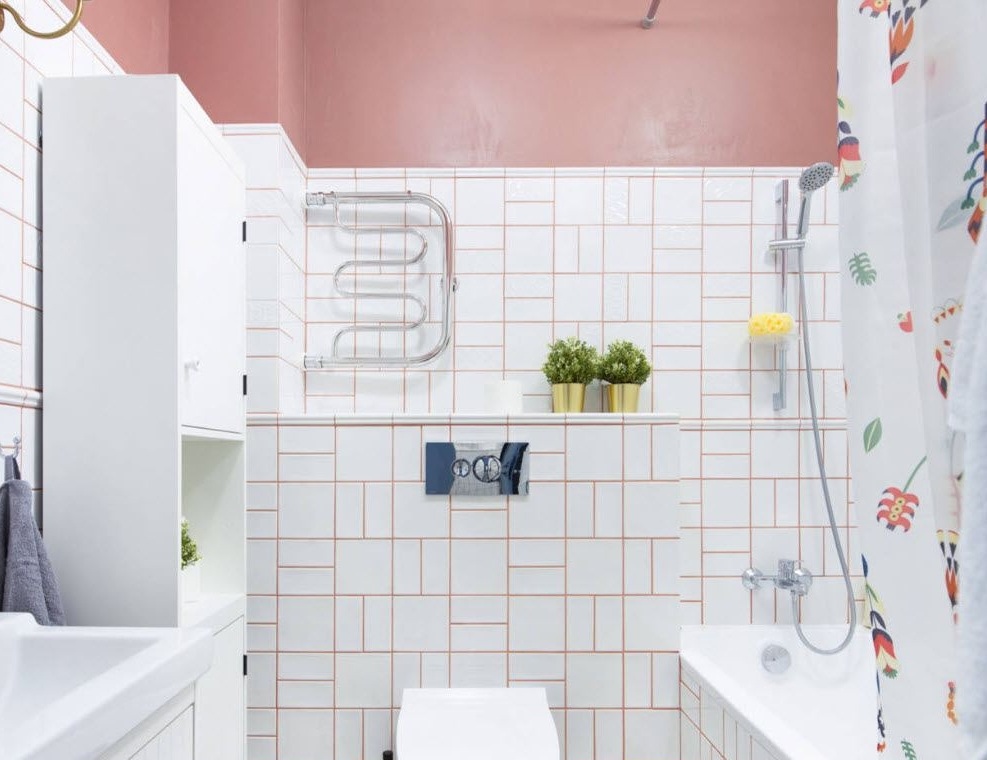
Laying tiles in the shower
A typical shower cubicle has a height of 200 cm. The tiles on the wall there should be placed to its upper edge. But if a bathtub or washbasin is installed nearby, although this is not necessary, tiles in these places can also be laid to a height of 2 m. In the latter case, the internal architecture will be consistent.
Tiles in the bathroom on the floor of the wall or laying to the height of the sink
If the bathroom does not have a cabin or the shower is located behind the wall, the height of the tiles can be determined by the sink. Such tiles will be a kind of tall panels, reaching almost 120 cm. If the color of the material and the walls above it are contrasting, you should know that horizontal division of the surface, dropping just below half the height, visually raises the interior, and slightly lower it.
The reference point for determining the height of the tiles in the bathroom can also be the height of the door or other architectural element, as well as niche windows. If possible, tiles are placed at the height of the center element.
How to paint the walls in the bathroom?
Painting the walls in the bathroom is much easier than laying tiles, but you can make a mistake here. Learn the basic rules that everyone must follow in order for the room to be properly decorated.
A bathroom, like a kitchen, toilet, laundry, is a room called wet, because here surfaces can constantly come into contact with water. Therefore, fragments of walls in the sink, bathtub and shower, that is, subject to constant contact with humidity, must be covered with tiles. The rest of the bathroom can be painted. Unfortunately, too much moisture absorption through the walls carries a certain risk, especially in humid rooms, since excess steam condenses on the walls. In addition, if the room is warm, mold and fungus may appear. That's why it is so important to prepare the walls well and apply the appropriate paint.
How to prepare the walls?
- Firstly, you need to thoroughly clean the substrate from any dirt, dust and grease, for example, water with the addition of detergent. In the case of a moldy surface, you must remove the old layers of paint, wash the wall with water with the addition of an antifungal agent and brush.
- Secondly, when the wall is dry, you must level it. Damage to the plaster is complemented by a gypsum finish or filler, which is then smoothed out with fine-grained abrasive paper. Then, with a brush or a damp cloth, all dust is removed, most of which is collected in the corners.
- Thirdly, the wall must be primed. Do not skip this step, as stains, discoloration and roughness of the coating may appear after painting.
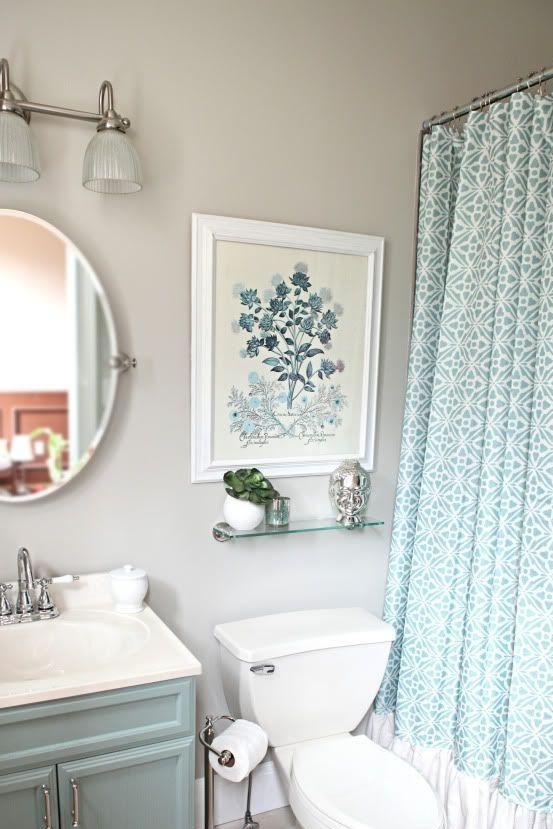
Paint selection
First you need to decide what paint you will paint the bathroom, and then buy a ready-to-use primer recommended by the same manufacturer. After priming, the wall should dry well. For wet rooms, paints or special moisture-resistant paints and varnishes are recommended. The packaging must indicate that the product is intended for bathrooms.The paint must be resistant to washing and cleaning with detergents, and also protected from bacteria or mold.
Wall colors in the bathroom 2019: fashion offers for arrangements
A small home SPA is being created in the bathroom today. The room is carefully decorated to be functional and meet aesthetic needs. People often spend a lot of time in the bathroom, so you should not compromise, since everyone deserves the most beautiful and comfortable room for hygiene. What color should the bathroom walls be? It is difficult to give a definite answer. The possibilities are endless, and most of them may be your preference. Here are some proven tips.
Earth palette
Natural color works well in bathrooms. Bronze, beige and gray bring a pleasant, warm climate to the interior, and this effect is enhanced by the use of natural materials in it. In a room arranged in this way, it’s good to relax and put yourself in order, especially for women. The skin looks much better surrounded by warm tones than when the light incident on it takes on the shade of green-blue walls. Do you want the bathroom to be eco-friendly, where you can relax after a hard day? Bet on an earthen palette.

Sea breeze
Do not completely abandon the colder shades. Some people like the feeling of coolness in the bathroom, since in such conditions a better recovery occurs. It is worth choosing blue and celedin. They will be in perfect harmony with white fixtures and light furniture. When you add a few beige and green elements to them, as well as bright points of light, you can feel like on a sunny Greek beach.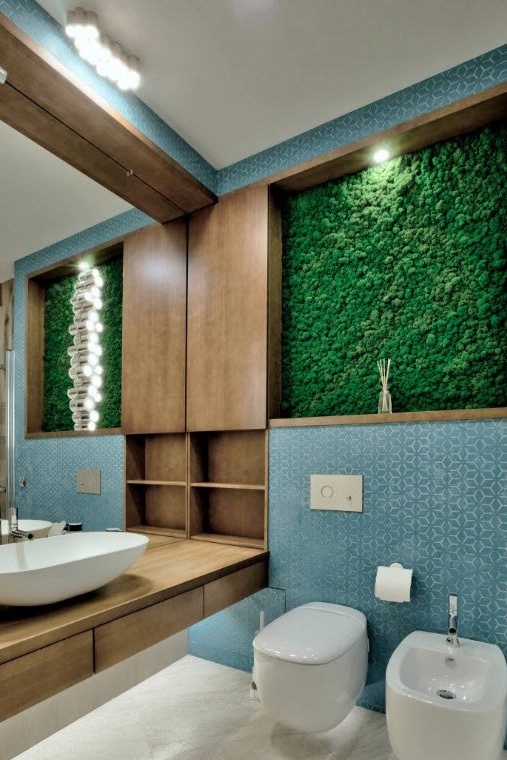
Gray area
The feeling of coolness will also give the dominance of gray on the walls. This solution has one main advantage - it is extremely elegant. Works great in the interiors of modern men. Are you an active man who loves to take a quick shower, and also appreciates the high quality of workmanship and materials? Your need for luxury, a strong and dynamic character are emphasized by the graphite color on the walls and plumbing from an exclusive collection.
Bright colors in a modern style.
Gray often appears in modern bathroom interiors, there will be a lot of it, but the shade and type of surface can be decorated with bright accessories. Interiors are governed by their own laws, and the most daring contrasts are welcome here. Therefore, when designing a bathroom in a modern style, do not forget to add bright colors. Red, turquoise, yellow and orange shades will look good. Decorate the walls in a neutral tone and take care of colorful accessories. The coolness of the interior is sometimes obvious - the matte surface combined with the warmth of colors provides a pleasant feeling for users of such a bathroom.


When designing your dream bathroom, it's best to be consistent. Color decisions should be made independently, but after preliminary consultation with a specialist and viewing the visualization. Finishing a bathroom is not an easy task. On the one hand, you want this room to be interesting, spectacular, fit into the design of the rest of the apartment, but on the other hand, the room should be practical.
The bathroom is one of those rooms in which quality should be the most important feature of the finish you choose. There is no place for unverified products. Materials for wall decoration must be resistant to moisture, water, temperature changes. The current tendency to use natural finishes in the interior, such as wood or concrete, does not always work in the bathroom. The best choice is proven ceramic tile, paint and wall panel.


